Terence Davies & Rachel Weisz The Deep Blue Sea
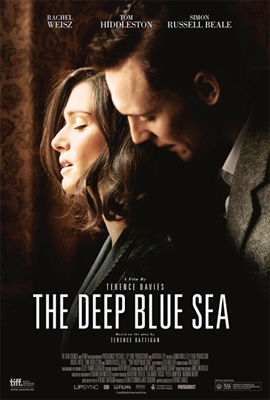
The Deep Blue Sea
Cast: Rachel Weisz, Simon Russell Beale, Tom HiddlestonDirector: Terence Davies
Genre: Drama, Romance
Rated: M
Running Time: 98 minutes
Synopsis: The story is told from Hester's POV, both in the present and in her memories of the past.
The story takes place between 1949-1950, with one flashback to 1940.
As the opening credits begin, we hear the last words of Hester Collyer's suicide note to her lover, Freddie Page.
It is night. We open in a badly blitzed neighbourhood in London one Sunday evening in the early 1950s. Derelict houses sit next to seedy boarding houses and a bomb-site dominates the end of the street. The scars of the Second World War are everywhere to be seen. In one boarding house, we see a landlady, Mrs Elton, put out her milk bottles for the night. Unbeknown to her, one of her tenants- Hester Collyer- is preparing to take her own life. She leaves the suicide note on the mantelpiece addressed to 'Freddie'. She lies down in front of the gas fire and turns on the gas. She drifts into unconsciousness...
Hester recalls the warm, comfortable home she shared with her warm, comfortable husband, Sir William Collyer, a celebrated lawyer. She then remembers meeting Freddie Page- a handsome ex- RAF pilot- younger than she- on a visit to the Golf Club at Sunningdale. The moment he touches her, she realises that she has fallen in love. Despite Hester's conventional sense of morality, they soon begin an adulterous affair. She is sexually satisfied for the first time in her life.
Hester's reverie abruptly stops. It is early on Monday morning. Some other tenants in the boarding house have smelt gas escaping from Hester's flat. Mrs Elton lets herself in with another tenant, Phillip Welch. They're lucky to find that the gas meter has run out.
They attempt to revive Hester and send down for Mr Miller, a tenant on the floor below. Miller is a mysterious figure who seems to have medical knowledge, but will not admit that he's a doctor. He forces Hester to vomit up the aspirin she has taken. She recovers but asks that nobody reveal her 'accident' to Freddie. She takes the suicide note and puts it into her dressing gown pocket. She smokes and remembers the past...
Hester remembers her father- an anglican vicar- upbraiding her for her adultery. He advises her to go back to her husband. She then remembers a weekend at her husband's monstrous mother's house. Mrs Collyer has little time for Hester and is wary of her daughter-in-law's passionate nature. Collyer overhears Hester on the phone to Freddie. Hester confesses her infidelity and tells Collyer she is in love with Freddie. Her feelings for Freddie are overwhelming. Collyer tells Hester he never wants to see her again.
Hester moves in to Freddie's grim bedsit. The couple pretend that they are married to the landlady, Mrs Elton. Freddie thinks Hester will make the flat feel like home 'in no time'.
By now, it's Monday afternoon. Freddie breezes in from playing golf at Sunningdale. He's charming and upbeat as ever. He has the possibility of a job with a South American he has met. He doesn't notice Hester's silence for some time. Suddenly the penny drops; he forgot her birthday. Last night she had prepared a special meal. He's apologetic, but it's not a big deal, is it? Hester relents. They kiss passionately, and Freddie's casual cruelty seems forgotten. But whilst Freddie is looking for some cigarettes in her dressing gown pocket, he finds the suicide note. Appalled, he leaves the flat in a fury. As Hester hurries to follow him, she runs into her estranged husband on the landing. Mrs Elton was worried about her and has contacted him.
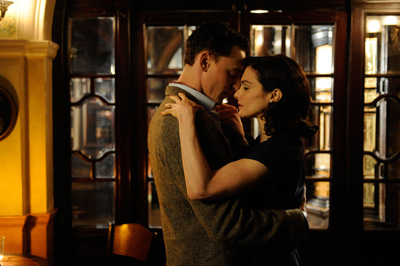 Hester invites Collyer into the flat. It is the first time he has seen her since she left him. She thought he never wanted to see her again? Though he is angry with her, Collyer is also concerned. He wonders what can have driven Hester to suicide? Hester explains that it's not money and Freddie isn't being unfaithful. She's simply ashamed of finding herself in this position; a conventional woman driven by desire for a man who doesn't even love her. Collyer hopes she can find a way for him to help her and leaves.
Hester invites Collyer into the flat. It is the first time he has seen her since she left him. She thought he never wanted to see her again? Though he is angry with her, Collyer is also concerned. He wonders what can have driven Hester to suicide? Hester explains that it's not money and Freddie isn't being unfaithful. She's simply ashamed of finding herself in this position; a conventional woman driven by desire for a man who doesn't even love her. Collyer hopes she can find a way for him to help her and leaves.As night falls, Hester goes to find Freddie in a local pub where he has been drinking with his old RAF friend, Jackie Jackson. Outside the pub, the lovers quarrel passionately. Freddie is tired of Hester's manipulative ways and her needy sensuality. Hester pleads with him to come home with her. He tells her the relationship is over. He tosses her a coin for the gas meter. Just in case he's late for dinner again. He doesn't want it running out this time. Hester is heartbroken.
Hester muses on her past with Freddie. A row at an art gallery indicates how little Freddie is interested in the cultured world that Hester has previously enjoyed. Then she remembers the pleasure of being with Freddie, singing in the pub with his friends, and the intense romance of her times with him as they would dance alone together. It is only in romantic, sensual moments with Freddie that Hester feels her new life is worth the old one she has given up.
From a public call box, Hester rings Freddie at Jackie and Liz's house. She'd like him to come home and collect his things himself. She just wants to see him one more time. Freddie puts the phone down on her. Deeply wounded, Hester goes down into a tube station, and stands, in agony, on the edge of the platform. Is she about to try to kill herself a second time? As the train approaches, she remembers the past...
Hester recalls being in a crowded tube station during the war, where everyone was taking cover from the blitz above. She remembers being comforted by Collyer. Faced with the memory of so many people wanting to preserve their lives- does she really want to extinguish her own?
The tube train passes by. Hester decides to go home. Outside the boarding house, Collyer is waiting, still concerned about her. He offers her the possibility of a new life with him, but Hester refuses; she can never go back to her old life.
As Hester enters the house, Mrs Elton asks for her help, Hester watches as Mrs Elton tenderly soothes her dying husband. In the darkened room, Mrs Elton tells Hester what true love is - 'wiping someone's arse or changing the sheets after they've wet themselves but never letting them lose their dignity so that you can both go on...'
Freddie is waiting for Hester in their bedsit. He tells Hester that he is taking the job in South America- and that he is going by himself; he's leaving her. Hester begs Freddie to stay for one more night- she can't bear being alone.
Next morning, Hester helps Freddie get his things ready to leave. Neither can bear to let the other go, but they won't ask the other to stay. Freddie leaves for the last time. And Hester has the courage, finally, to let him go.
Hester goes to the gas fire- and for a moment ignites the gas. Will she attempt suicide again? But this time, Hester has decided to live. She lights the gas, opens the curtains and faces a new day- and a new life, alone.
Release Date: April 12th, 2012
The Title
'Between the Devil and the Deep Blue Sea' is a phrase meaning a dilemma-i.e. to choose between two undesirable situations (equivalent to 'between a rock and a hard place'). Its original meaning may be that of a nautical reference citing the deep blue sea and a 'devil'-a seam (where two hull planks meet) that is difficult to reach on a ship. More specifically, it may have been a reference to being a member of the 'lower deck' or crew of a sailing ship in the English Navy. Such sailors were often pressed into service unwillingly; one who was 'between the devil and the deep blue sea' would literally be beneath the upper deck (officer territory)--thus a member of the crew.
About the Production
2011 marks the centenary of the birth of Terence Rattigan, one of the most successful and celebrated playwrights of the 20th Century. An expert in the exposure of British insecurities about sex and class, Rattigan's The Deep Blue Sea is regarded as his finest achievement. The story of a woman who risks everything for the man she loves, The Deep Blue Sea is a painful, uncompromising study of the fear of loneliness and the frustratingly unreliable nature of love.
Now Terence Davies, the award-winning director of Distant Voices, Still Lives, The Long Day Closes and The House of Mirth, brings this seminal work to the big screen. In Davies' hands, the story in which Rattigan explored how "the idea of love is inexplicable in terms of logic", becomes more than a love triangle; it becomes a dilemma that reflects the state of the nation in the early 1950s. Britain is Great no longer, but bankrupt as an economy, exhausted as a culture and spent as a world power. It is a time of rationing and privation where luxury and indulgence - like Hester's former life - are a pre-war memory.
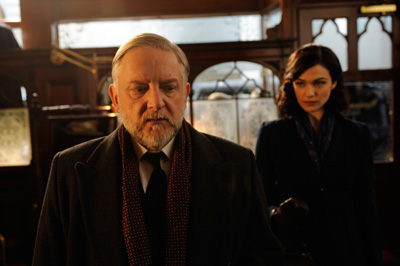 Hester's story of the fulfilment of the individual - a rallying cry for personal freedom, particularly for women - reflects the massive social and cultural transitions ushered in by the Second World War, but that only resulted in real change in the 1960s.
Hester's story of the fulfilment of the individual - a rallying cry for personal freedom, particularly for women - reflects the massive social and cultural transitions ushered in by the Second World War, but that only resulted in real change in the 1960s. It was producer Sean O'Connor who brought Terence Rattigan and Terence Davies together. Sean O'Connor was asked by the Rattigan estate to contribute to the celebrations of the Rattigan Centenary and, having been a good friend of the late Frith Banbury, the theatre director who brought The Deep Blue Sea to the London stage in 1952 with Peggy Ashcroft as 'Hester', Sean O'Connor began to develop a film adaptation of the play. He recognised in Terence Davies a filmmaker who would do the play justice, partly because of his skill as a director and partly because of the common threads running through Terence Davies' and Rattigan's work, mostly notably the exploration of the position of women in a repressive society and of Britain in the aftermath of the Second World War.
"Distant Voices, Still Lives is one of my favourite films. It's all about the position of women in the 50s and it's a very painful, hard and devastating film," says Sean O'Connor. " In the screenplay for The Deep Blue Sea he has filtered the story entirely through Hester's point of view and stripped away a lot of the exposition to get right to the heart of the story. It feels much bigger than just the story of a love triangle; it has something to say about a nation climbing out of the rubble of war and trying to make something of itself.
All the characters are shaped by the war and they are all damaged in some way. The essential story is exactly Rattigan, but by removing the exposition and the extraneous characters it's clearer what the story is and it's become more like a symbolist story about individual freedom and individual fulfilment."
Indeed, given Terence Davies' well-known admiration for the great popular melodramas of the 1940s and 50s - once dismissed as "women's pictures" but now regarded as serious articulations of women's lives and desires, it seemed only natural that he would respond to the themes in the play. Nevertheless, Terence Davies was wary at first about taking on the project, the first play he has adapted for the big screen. But the more he read the play, the more the themes engaged him. "It's the story of a woman who leaves her husband, William, and her luxurious life for Freddie, the younger man with whom she's fallen madly in love. It's the first time she's felt erotic love - her marriage was about companionship with a kind man - and it overwhelms her. After re-reading the play, I realised that it was about love - which is the strangest of all human emotions. It's about how each character - Hester, her husband Collyer and Freddie - wants a different form of love from the person they're in love with, and how it can't be given. And that's a heart-breaking theme.
"If you didn't grow up in 1950s, you have no idea about how very shocking it was for a woman like her to do what she did," he continues. "She does something very courageous and bohemian. Modern audiences won't fully understand how shocking her action would have been then. But the point is that she gives up someone who loves her because she's found erotic love. And the idea of doing something because you're in the thrall of an emotion you can't control, that's timeless."
Terence Davies was careful not to impose any moral judgements on the characters. "I wanted there to be sympathy for all the characters even though they do things that could be judged wrong or hurtful. We see a lot of different characters - it's kind of a microcosm of what Britain was like then - and I wanted to make them all human because as soon as you give them humanity, you can accept their good and bad points. So we have Mrs Elton who cares for her husband and Mr Miller who is brusque but he's tender and offers help. They are all needy people but they've all got their different kinds of courage."
He was also aware of the similarity of the themes the play explores with those that have informed his previous work. "My films are always about outsiders," he says. "I've always felt like an outsider myself; I've always never felt part of life, I've always felt like a spectator. And I think that's what interests me about all the people and the things that I've written about. Lily Bart in House of Mirth is an outsider, and so is Hester here. The nature of time is another obsession. I love moving in and out of linear time because there's something thrilling about doing that. And the themes of the nature of love, the nature of guilt, the nature of behaving honourably even if it hurts someone else."
Opening up the story to the wider canvas of film presented its own challenges but also gave the director the opportunity to explore a different way to tell the story. "Cinema and the theatre are different. Cinema can reveal things," says Terence Davies. "And if you can reveal things, then there's no need to talk about it. But you can also show the ambiguities which arise between the cuts. And you can move in and out of time. You can dissolve and the audience knows it's time past or time forward. So you can play around with the linear story and the remembered story, which influences here the whole narrative. I love that idea of people being in reverie, thinking of the past and how it affects their present."
If these stylistic touches recall one of the seminal films of the 1940s - David Lean's Brief Encounter - it is certainly no accident. In The Deep Blue Sea Davies plays homage both to that Lean classic and to others such as Letter From an Unknown Woman, Now Voyager, The Heiress, It Always Rains on Sunday and All That Heaven Allows.
Indeed, Brief Encounter haunts Terence Davies ' The Deep Blue Sea. Both are stories about conventional women who are torn between the fulfilment of desire and the oppression of convention. As in Brief Encounter, The Deep Blue Sea is a subjective narrative - the whole story is filtered through Hester's consciousness. Like Celia Johnson's Laura, Hester articulates her story to the audience in voice over, drawing a real sense of intimacy. This is her story, her journey. And, again, The Deep Blue Sea is not a linear narrative, but a patchwork of memory and real-time - a unique style that Davies has previously explored in his autobiographical works, Distant Voice, Still Lives and The Long Day Closes.
Seam O'Connor and Terence Davies initially developed the screenplay with the support of the Rattigan Estate. In June 2010, Sean O'Connor took the script to the UK Film Council who immediately expressed their interest in backing the film. At that point, producer Kate Ogborn joined the production. Together, Kate Ogborn and Sean O'Connor set about putting the financing together, their ambition being to shoot the film before the end of the year, in order for it to be ready for release in the UK in 2011 to tie in with the Rattigan Centenary celebrations. In July 2010, the recently elected British Government announced the closure of the UK Film Council. There was some anxiety that the production might be a casualty of this, however, fortunately, the UK Film Council were able to maintain their investment in the film as well as their huge enthusiasm and support for it. Shooting commenced in London in November 2010, just five months after the initial submission of the script.
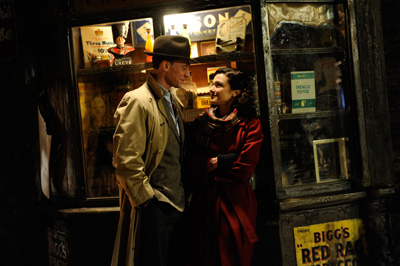 The Deep Blue Sea is a Camberwell/Fly Film Production and the finance came from the UK Film Council, Film4 (who had previously worked with Terence Davies on Distant Voices, Still Lives, The Long Day Closes and The House of Mirth), Lipsync Productions, Protagonist Pictures and Artificial Eye.
The Deep Blue Sea is a Camberwell/Fly Film Production and the finance came from the UK Film Council, Film4 (who had previously worked with Terence Davies on Distant Voices, Still Lives, The Long Day Closes and The House of Mirth), Lipsync Productions, Protagonist Pictures and Artificial Eye. The Cast
Rachel Weisz takes the lead role of Hester, with Simon Russell Beale as her cuckolded husband, William, and Tom Hiddleston as her lover, Freddie.
Strange though it may seem, Terence Davies was unaware of Rachel Weisz and her work until he chanced upon Swept by the Sea (US:Amy Foster) one evening on television. "This girl came on with a luminosity that absolutely knocked me out. When I found out who it was as the credits rolled, I phoned up my manager to ask if he knew of a Rachel Weisz. He said, 'Terence Davies, you're only one who hasn't!' She has the kind of luminosity that Celia Johnson had. I sent her the script and we talked and she said yes."
Although Rachel Weisz was unfamiliar with Terence Davies' work, she recognised what she calls a "dream combination" of a riveting story, fascinating character and passionate director.
"It's a really radical story," she says, "about a woman who leaves financial and emotional security for a younger man who has no money and who's mentally unstable because she discovers love and sex. It's an existential story about a woman trying to make her own life not one defined by her father, who's a vicar and had strong sense of morality, and her husband a judge who has a strong sense of decency. She does something incredibly indecent and although it's not shocking to us now, it's radical in that she's a woman trying to shape her own life for herself. Everyone can relate to the idea of finding one's own identity without being defined by another person. That will be never be an old-fashioned idea."
Rachel Weisz and Terence Davies initially had different takes on the certain aspects of the story. "I saw the relationship between Hester and her husband William Collyer as much less loving than Terence Davies saw it. To me, it as a completely stale marriage that was bankrupt of any joy or warmth or love. As we worked on it I came to see that there is a friendship between them, they're both literary and they can joke to each other, they're more like brother and sister, but it's safe and secure without passion or excitement, it's predictable and asexual. Freddie is stuck in the war - a prisoner in a way - and he's a drinker and he can't hold down a job. Hester falls head over heels in love with him and it's not a choice and she can't ignore it."
The complexity of the character of Hester inspired Rachel Weisz. "Hester is a very bold person and she's broken free. She loves Freddie more than he loves her and she's pretty shameless about it. She loses her dignity around him and doesn't really care and that's a lot of fun to play."
Working with Terence Davies for the first time, Rachel Weisz was struck by his sensitivity both as a writer and a director. "Terence Davies has constructed the screenplay in a very clever way," she explains. "It starts with Hester attempting suicide and then it goes into flashback and you see her past life. Working with Terence Davies was intense. I was very moved and touched by him as a person and as a director, by his humanity and by his incredible flexibility as a director. He's incredibly disciplined in film grammar and he was very open to experimenting. He's a very special person."
When Simon Russell Beale was offered the part of William, he saw it as a chance to explore new emotional territory in this "very damaged man who is hurt and suffering". "He's a judge so he can be dismissive of servants and a bit imperious, but basically he's a kind man," says Simon Russell Beale. "And he comes back again and again to try and win her back, but also to help her. He loves her and that doesn't go away."
"It's a fantastic picture of the repression of drab post-war Britain in the '50s, that very rigid way of behaving, which said you don't divorce your husband and you don't behave badly," continues Simon Russell Beale.
"What's wonderful about the main character is that she decides to break out of the cage she's been locked in. Hester and William's marriage is not unhappy, they can perfectly muddle along quite contentedly, but something is missing in Hester's life, and that's what's clever about the writing. Hester has a spine of steel - this woman does something to all intents and purposes wrong and she hurts somebody badly, but at the same time you have immense sympathy for her desire to do it. Rattigan is the English Chekov, in the depth of his analysis of human pain."
He describes working with Terence Davies as "a complete joy". "Terence Davies is brilliant at summing up that atmosphere which he understands very well, of rationing and things being short and there not being a great deal of luxury around. He's done a brilliant job and he writes women beautifully and he's very sensitive which is perfect for this material as it's all about nuance and tiny little changes in delivery. When I asked him how he learned his visual brilliance, he said he went to see a lot of films with his sisters and on the way home he would discuss the shots. He's a perfectionist."
Rising British star Tom Hiddleston takes on one of his most challenging roles as Freddie. It was a part he fought to get. "It appears to be set in a very constricted time about a very constrained woman in a constrained world and it's about the triumph of feeling over propriety," says the actor.
"Hester lives in a world not of her design, firstly under her vicar father's rule and then under her judge husband's rule. When she meets Freddie she's attracted by the freeness of his spirit and having an affair with him is about the heart being ungovernable and you can't legislate for the heart. I also loved how three- dimensional each character was so there was no judgement - Collyer is an impeccable man and isn't at fault, it's just Hester needs love and Freddie can offer it. It seemed very human and compassionate."
As a decorated pilot who fought in the Battle of Britain, Freddie has trouble coming to terms with the extent of Hester's actions. "Post-war England has been difficult for Freddie, he lives for the moment, he's a free spirit with no censor on his emotions," says Tom Hiddleston. "Hester's attempted suicide pulls him up short and makes him look at death again in a way he doesn't want to. That she could value her life so little enrages him as most of his friends died in the war. You can see then how vulnerable he is. He can't have her death on his conscience or conduct a relationship at that pitch, it's a very compassionate take on humanity by the writer."
Tom Hiddleston's commitment to the role impressed the film's producers. Says Sean O'Connor: "Freddie was the difficult part to cast; you need someone sexy and seductive and charming, but who can treat Hester really badly and be difficult and it's difficult to do both. Terence Davies liked him instantly and he's very instinctive and usually knows within 20 seconds. Tom Hiddleston was brilliantly prepared and he played the role exactly as Terence Davies had imagined it. He cared very much about the character, he was always fighting Freddie's corner and he brought a terrible damage to his character. Freddie's young and has been surrounded by death and has all this pain inside him and it's understandable that he's going to be difficult and that the relationship with Hester will be a very self-destructive one."
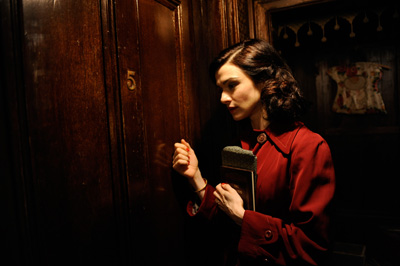 "Working with Terence Davies was heaven", says Tom Hiddleston. "He has the wisdom of a sage and the innocence of a boy. The time is right for Terence Davies. He's become known as one of our very best depictors of the 1950s on the screen, he knows it so well, it's in his being. He's interested in the complications and ambiguities of the human heart. The material is very poetic and so is he; it's about the mystery of love and that appeals to him."
"Working with Terence Davies was heaven", says Tom Hiddleston. "He has the wisdom of a sage and the innocence of a boy. The time is right for Terence Davies. He's become known as one of our very best depictors of the 1950s on the screen, he knows it so well, it's in his being. He's interested in the complications and ambiguities of the human heart. The material is very poetic and so is he; it's about the mystery of love and that appeals to him." Recreating Post-War Britain
With The Deep Blue Sea, Terence Davies revisits the milieu of his definitive films, Distant Voices, Still Lives and The Long Day Closes - post war Britain in the 1950s.
Just as he had done in those two masterpieces, Terence Davies was keen to avoid the usual trappings of British period films. Says producer Sean O'Connor: "This is an anti-heritage period film about what it was like to live in the 1950s. 1947 was the harshest winter on record, the country was bankrupt, we had famously won the war but lost the peace and we were living in a society of some privation and confusion and devastation - everything was dark and dirty and cold. We wanted to articulate how depressed and depressing it was in 1949 to honour the people who lived through that period."
"We were influenced by films of that period too," concurs producer Kate Ogborn, "but rather than Brief Encounter which has a comforting glow we looked at Alexander Mackendrick's Mandy, which is set in a world of bomb sites, and Robert Hamer's It Always Rains on Sundays, about twenty-four hours in the life of a housewife played by Googie Withers, as well as the photographs by people like Bill Brandt who went into ordinary homes and documented people's lives.
"I don't think Terence Davies does realism," she continues. "His films are emotionally authentic to his memories, but they are more heightened than social realist films. The Deep Blue Sea looks ravishing, but it doesn't feel like we've 'packaged' the period. We're telling the story through the visuals and performances and it's very rich visually. Terence Davies was also keen to give a softer look to the film so it's almost on the edge of focus and its look creates a tension with the raw emotional content."
Terence Davies's personal recollections of growing up in the 1950s have informed his best work and it also informs the look of The Deep Blue Sea. "Because I grew up in the 1950s, I know what the texture felt like," he says. "We were bankrupt after the war and everything was drab. You very rarely saw primary colours, except in Hollywood musicals and the red lipstick that women wore. If a woman wore a dress with some colour on it, she looked like a Hollywood movie star. I recognised what Hester has given up - a quite luxurious life for one drab room in a lodging house with no toilet."
But despite the drab surroundings of much of the story, Terence Davies was keen to infuse the film with a rich visual texture. Cinematographer Florian Hoffmeister created a look of which brought pools of light and textured shadow into the film.
"I'm obsessed with Vermeer," says Terence Davies. "I love the glow you achieve when you switch on a red light in a drab room - you get a wonderful glow. In the scene we shot in Aldwych for the scene in the London underground station, we had little paraffin lamps causing little pools of like candles and very little else. It made it warm and cosy like a womb. And that warm glow makes what is an unbearable situation - waiting for the bombs to drop while you're underground - bearable."
Production designer James Merifield, whose credits include Rowan Joffe's Brighton Rock and the BBC adaptation of Little Dorrit, had the challenge of creating a look for a story that mostly plays out in the very contained environment of one room.
Terence Davies showed him a photo - sepia, smudged and reminiscent of the director's childhood - and it provided the inspiration for Merifield's designs.
"I thought there was the opportunity to do something quite stylised, quite heightened but still true to the story which is obviously very real in terms of the performances," says the designer. "So I followed this photograph and created the whole look with sepia tones, and took all the colours and de-saturated them."
The result is an autumnal colour palette of brown, ochre, butterscotch and toffee in which splashes of colour may suddenly appear - the interior of a suitcase or a ruby red coat that Hester wears, for example. "If you put a primary colour against a saturated background, it becomes much warmer," says Terence Davies. "And because the main palette is saturated, you really notice the colour. I wanted to recreate something of the feeling of seeing that bright Technicolor at the movies - you'd think 'Oh God, doesn't that look wonderful!' - and James Merifield and costume designer Ruth Myers knew exactly what I meant. They did a fabulous job."
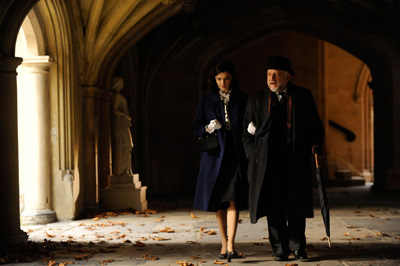 "Terence Davies is easy to understand as he wears his heart on his sleeve," says James Merifield. "His classic line is "If I can't see the shot, I can't shoot here" so it was very much a case of learning about Terence Davies 's needs, what I know will work and then presenting him with those options. I'm obsessed with detail and so is Terence and because I knew he was going to shoot every single nook and cranny of the set, I had to make sure every corner was attended to."
"Terence Davies is easy to understand as he wears his heart on his sleeve," says James Merifield. "His classic line is "If I can't see the shot, I can't shoot here" so it was very much a case of learning about Terence Davies 's needs, what I know will work and then presenting him with those options. I'm obsessed with detail and so is Terence and because I knew he was going to shoot every single nook and cranny of the set, I had to make sure every corner was attended to." Finding suitable locations in London proved a challenge. The play was originally set in Ladbroke Grove, the once run-down part of North Kensington which is now one of the most sought-after areas of the capital. The production shifted their search for locations to north and east London and in a stroke of luck, the team found a house in Islington that had not changed since the owner moved in in 1950. A remnant of the era, it was perfect for the bedsit Hester moves into. When the art department moved in they discovered the original 1940s' lino there which was used on the set in the studio at 3 Mills.
"It's increasingly hard to shoot 1940s' London," says Kate Ogborn. "It's hard to make a period film on a tight budget as it limits your choices and where you can put the camera and everyone had to be fairly inventive."
The Music
Terence Davies' work is hugely resonant with musical leitmotifs. The pulse of his work is meditative. For The Deep Blue Sea he utilises a heartbreaking and deeply passionate soundtrack with Samuel Barber's Violin Concerto. Throughout the film, the Violin Concerto articulates the depth and passion of Hester's dilemma, much in the same way that the Rachmaninov Piano Concerto No 2 articulates the emotional crisis of Celia Johnson's character in Brief Encounter. It is no co-incidence that Davies has chosen to stage Hester's second suicide attempt at a tube stationthis, of course, echoes Celia Johnson's suicidal thoughts at Milford Junction- both are women in extremis provoked to the consideration of extreme actions.
Returning to the milieu of the 1950s for the first time since The Long Day Closes, Terence Davies once again utilises popular music and pub sing-songs in order to explore the cultural background of the early 1950s. These songs place the story in a particular historical moment, but they also add a commentary on the situation of the main characters. For instance, Jo Stafford's You Belong To Me is both an exotic love song, but also expresses Hester's needy- and sometimes suffocating -love of Freddie. A traditional folk song, Molly Malone, provides a sing-song during an air-raid, but thematically this song of the life and death of a passionate young woman resonates directly with Hester's story.
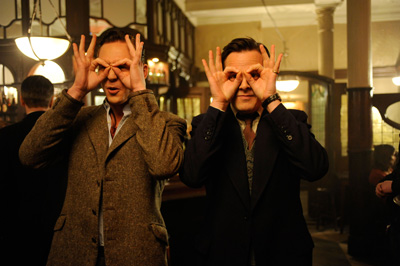 "The music is fundamental to the film," says Sean O'Connor, "and was there even before the screenplay was finished. The Barber piece has been the guide. It's beautiful but it has a sense of pain and that's a uniquely Terence Davies thing and there's also nostalgia which is classic Terence Davies. It's a meditative piece and it gives the film its rhythm. We played it on set so it literally infuses the shots and the acting so it all melds together with a strange alchemy."
"The music is fundamental to the film," says Sean O'Connor, "and was there even before the screenplay was finished. The Barber piece has been the guide. It's beautiful but it has a sense of pain and that's a uniquely Terence Davies thing and there's also nostalgia which is classic Terence Davies. It's a meditative piece and it gives the film its rhythm. We played it on set so it literally infuses the shots and the acting so it all melds together with a strange alchemy." MORE
- Mission: Impossible Fallout
- Glenn Close The Wife
- Allison Chhorn Stanley's Mouth Interview
- Benicio Del Toro Sicario: Day of the Soldado
- Dame Judi Dench Tea With The Dames
- Sandra Bullock Ocean's 8
- Chris Pratt Jurassic World: Fallen Kingdom
- Claudia Sangiorgi Dalimore and Michelle Grace...
- Rachel McAdams Disobedience Interview
- Sebastián Lelio and Alessandro Nivola...
- Perri Cummings Trench Interview



